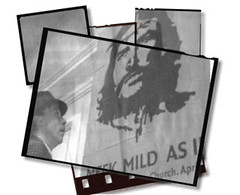Interesting discussions on intertextuality are floating through the blogosphere, Pete Phillips started it off with a post on Esler's new book (here), then followed up with a post (here), then Alan Bandy gave us a brief introduction (here), discussing how intertextuality and allusion differ.
Alan in a response to Loren Rosson stated that he favored allusion primarily because it retained the notion of authorial intention. Pete on the other hand in true postmodern fashion chooses his theory depending upon the wind patterns out there in the Peaks. I happen to be somewhere in the middle between Alan and Pete. Mondays - Wednesdays I favor Genette, Riffaterre, and Bloom; Thursdays and Fridays are my Kristeva and Barthes days (because we all need Barthes days!), Saturday I give over to Hirsch (just kidding), and like Pete on Sunday it just doesn't matter!
The following is from a yet to be finished dissertation on Paul and intertextuality:
I see intertextuality as essentially a theory of reading that insists that a text (for the moment to be understood in the narrower sense as a work, a canon, or a unit of writing) can neither exist nor function as a closed unit. Perhaps this can be best illustrated if we look at a text as the two sides of the same coin; on the one side we have the writer and the other side the reader. On the first side the writer is a reader of texts (in broadest sense such as social institutions, cultural icons, and all literary texts) before she is a creator of texts. Therefore the work is inevitably filled with references, quotations, and influences of every kind. This reiteration of past or of contemporary texts can range from the most conscious and sophisticated elaboration of another's work,[1] a scholarly use of sources,[2] a quotation (with or without the use of quotation marks),[3] to the snatches of conversation typical of a certain social milieu at a certain historical moment.[4] On the other side of the coin a text is available only through some process of reading (or hearing); what is produced at the moment of reading is due to the cross-fertilization of the packaged textual material (say a book) with all the texts which the reader brings to it. For example a delicate allusion to a work unknown to the reader, which therefore goes unnoticed, will have no effect in that reading. On the other hand, the reader's experience of some practice or theory unknown to the author may lead to a fresh interpretation.[5] Both sides of intertextuality, texts entering via writers and texts entering via readers, are, nevertheless both emotionally and politically charged. Texts are not transferred in a socio-political, or emotional vacuum.[6]
The theory of intertextuality then is a theory of reading that takes into account intertexts (texts, in the broadest sense, found within a certain text, in the narrowest sense), not as sources per say, but rather as possible aids in the process of signification. This process of close reading is all done with an understanding of the ideological nature of texts; both through the influence of the writer and the reader. This is no doubt a simple but nevertheless I hope helpful introduction to theory of intertextuality.
The more time I spend studying intertextuality the less I rest on authorial intention as the main determinant of meaning. We have the author, the text, and the addressee(near and far); none of these should be the privileged retainer of meaning. Namely, because they are all woven and crafted by previous texts. The very interesting question for me becomes the interplay between these texts and how they signify.
Peace,
---------------
[1] See Jorge Luis Borges's 'Pierre Menard, Author of Don Quixote', in which Menard writes with his own resources a new version of Don Quixote, which was rigorously and literally identical with Cervantes's text. Yet because of the two intervening centuries of history the work was invested not only with a new complexity and depth but also with an entirely different meaning.
[2] Of which a dissertation is a prime example.
[3] The New Testament's use of the Scripture's of Israel is often an example of the use of a quotation without any introductory formula, the ancient equivalent of quotation marks..
[4] Many of Charles Dickens's novels present us with a world crammed full of individual voices, sharing, competing, and clashing over different ways of speaking; yet the novels present no overall voice, no controlling and omnipotent narrator.
[5] John Frow, "Intertextuality and Ontology," in Intertextuality: Theories and Practices, ed. Michael Worton and Judith Still, (Manchester: Manchester University Press, 1990), 45-56,defines ten theses of intertextuality, which I think are helpful in summarizing the various concepts of intertextuality. By using the concept of intertextuality we understand that:
1) the text is self-contained but differential and historical;
2) texts are traces of otherness -- they are repetitions and transformations of other texts;
3) the absent texts constrain the text and are represented by/within it;
4) the representation may be implicit or explicit;
5) intertextual reference implies reference to the meanings stored in a genre;
6) the process of intertextuality in literature is governed by the structure of the literary system and the authority of the canon;
7) the text's relationship to discursive authority may not reflect authorial intention;
8) identifying an intertext is an interpretive act;
9) identifying the general genre or ideology of the source-text is more important than identifying the particular source; and
10) intertextuality is distinguished from source criticism by its stress on interpretation rather than mere influence or causality.
[6] Michael Worton and Judith Still, Intertextuality: Theories and Practices (Manchester: Manchester University Press, 1990), 1-2.











